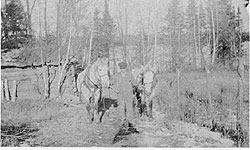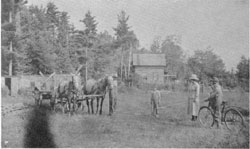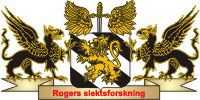|
Memories
from Bear Lake
PIONEER STORY
BEAR LAKE FARM
Part 1
I have been requested to write some
of my experiences of my early days in the southern part of Aitkin
County, so I will do the best I can.
I never had the time after I landed
in the United States to attend school as life's demands became too
pressing, but I went to work in an entirely "New England Yankee"
community in central Minnesota the first year I was here, which
was 1882. In the two years I was among them I got a good insight
of American life and background, something that few "newcomers"
get when they stay among their own people.
I was born the fifth of April in
1864 on the old Einstabøvoll farm, Valestrand, Sogn Parish,
Sunnhordaland, about fifty miles south of Bergen, Norway. Father
was a sailor and fisherman and the first implement I remember handling
was an oar. I, as a mere boy, started to go with Father to handle
the lobster traps, and to go after cod, herring and halibut as the
seasons changed. Both my father and mother had good educations for
their time, so they kept me at my books, and I could read quite
fluently at the age of seven. Some of my uncles were scholarly men,
and they sent me fine reading material which I read with great interest
as they came. Father who in his younger days had sailed the seven
seas with both Norwegian and English ships could also feed my mind
with tales from the wide world. The world was a good deal larger
at that time than it is now. Instead of flying around the globe
in less than a week, it took them a year from England to China and
back in 1858, and many exciting things happened in that time. As
a result of my reading and the tales Father told, I acquired quite
an extensive knowledge of what went on in the world.
I was the oldest of three children.
Lorentz was born in 1867, and Cornelius was born in 1872. Father
felt that there wouldn't be any future for the three of us on the
coast, so he decided to immigrate to the United States. We left
Norway in 1882. We came first to Minneapolis, and a little later
to Wilmar, Minnesota where an old friend lived. We took some land
in the northern part of Kandiyohi County. In 1893 when my youngest
brother was 21, we decided to look for homestead land. Providence
leads us to Aitkin County where the family centre has been since.
I was married in Chicago in 1903 to Caroline Hegna, who had come
there two years before from Skien, Norway. She died in 1931 at an
age of 61 years, leaving six children and myself to mourn her departure.
My homestead, (the Bear Lake Farm,
as we fondly call it) is located in Section 4 in Idun Township in
the southern part of Aitkin County. The original homestead consisted
of 151 acres, 9 acres of which is in the lake. Later I bought the
fraction adjoining on the east, 31 acres in section 3, so the farm
consists of 182 acres. At that time it was all solid timber. My
farm lies on the southern side of the lake, and takes in half a
mile of lakeshore. As there is a wide correction line in the government
survey on the north side of the township, it explains how we could
get four almost full homesteads besides the lake in one section.
Maybe we realized after we got settled
we had undertaken a job that would take long life time to accomplish,
but we were young and had "crossed the river" so we had
to go to it. First, we had to cut roads. The first two settlers
in Idun Township, Hans
Melsby
and Peter Hagen, had cut in from John Skretting's place in Eastside
Township, Mille Lacs County, two miles west, in 1891. The year after,
Ingvald
Melsby
cut from the southwest part of section 6 to his claim in section
8. When we started in 1893, we started on the east line of section
8, and cut across section 5 and most of section 4 to Bear Lake.
Those roads had a beginning and destination, but had no regard for
straightness, or survey lines. We had to keep on high ground as
much as possible, circle the swamps by long curves, and at times
we would use an old beaver dam as a bridge, and the embankment as
a roadbed. We also had to avoid all the larger trees as much as
possible as everything had to be cut level with the ground. The
road looked as if a hugh snake had crawled through the woods. When
there had been a strong wind the road would be filled with windfalls,
and it took hours to cut them out. We never left the place without
a sharp axe in the wagon.
 |
The first house
I built was logged of round tamarack logs, 12' x 16', and roofed
with split poles with birch bark and mud on the top. I used
it from the start as a blacksmith shop. I had learnt the trade
in Norway and here in the wilderness it became a necessity.
We needed sleds and various implements used in the woods, and
also horseshoeing needed to be done. To comply with the Homestead
law, I put a bed in one corner and slept there occasionally. |
| Several years later
in 1897, I set up a good log house of hewed pine logs. They
were hewed to six inches and carefully grooved. The floor and
ceiling were made from hand-sawn lumber and planed with a hand
plane worked by two men straddling the board. The house is still
standing there, sided and included in a frame house built years
later. My father built himself a nice log house the same way.
We roofed our buildings with split balsam poles, hewed and peeled
and covered with birch bark, later replaced with shingles. |
 |
We boys got quite used to building
log houses and during an eight-year period built about 20 different
buildings on our homesteads, and hardly a nail was used in their
construction. Father who was too old to partake in all the hard
outside work, but was an expert in carpentry and woodcarving, busied
himself with filling up our houses with homemade furniture, chairs,
bureaus, bookcases, bedsteads, tables, etc. It was many years before
we spent any money on new furniture, and some of the old furniture
is still in use.
As to farming conditions, we came
from prairie country, and we did run up against snag. We had counted
on being able to grub out at least enough land for potatoes and
other crops, but we found the roots of the forest too hard to contend
with that we had to plant our potatoes the primitive way that evidently
the Pilgrims used. We cut a little hole in the ground, dropped a
seed in, and then put loose leaf mold on top of the seed. It was
a lot of work, but between us we managed to raise 100 bushels the
first season in 1895. We cut hay with scythes for several years.
The first year we found hay out by Mille Lacs, but later we found
good hay meadows just west and south of the present village of McGrath.
This again involved cutting several miles of road. My brother had
slashed down a few acres of timber and the next spring he started
to burn and clear it. The fire began spread rapidly over the entire
slashing. When we finally got it under control, the burned-over
piece looked so inviting for a seedbed that we all went to work
and skidded everything out, and seeded oats. Then we hitched a horse
to a big balsam top and in that way got the ground harrowed between
the stumps. We raised 300 bushels of oats on that land that year.
It was harvested with a cradle. Our neighbors used the same methods.
Several years went by before we could get decent plowland. It was
not until after we got stump-pullers and dynamite, that plowland
began to increase in any marked degree. I read once in a book on
pioneer life that it took twenty-five years to develop a farm in
the timber, while it took ten years in the open areas. I can testify
to the truth of that.
As far as schools were concerned,
the first few years there were only two or three children of school
age in the settlement, and they could go to the school over at Opstead,
about two or three miles west. I believe it was in 1896 when the
county school board appropriated $50.00 for two months school, and
as Ingvald
Melsby
had built a nice new cabin on his claim at Cedar Lake he let the
district have the use of it for a schoolhouse that winter. Berentina
Anderson, now Mrs. Peter Sehlin, who lived with her father on a
claim just over the country line, got a permit to teach and received
$25.00 a month for the two months. In 1897, (I forget the precise
date) we organized the school district. We proposed to build two
schoolhouses as several families had moved further east, one on
the south line of section 5, and another on the east line of section
10. We decided to build of hewn pine logs as the cheapest way. Each
settler was to donate a few good-sized logs. I think the inside
was originally 16' x 20'. Later on entry of frame was added to it.
The contract for the logging was awarded to Reiar Bakke, George
Arneson and Knut Olson for the sum of $125.00 for the two buildings.
Lumber could now be gotten from the not too distant sawmills, and
used for a town hall. The children are now transported by bus to
the McGrath Consolidated School.
I cannot recall the exact date, as
I have not all my files at hand, but about 1896 we began to talk
about the advisability of organizing the township, so we could get
our own funds for roads and public improvements. We called a public
meeting and made an application to the county board for organization.
We all agreed on that. Then there arose a lively debate about a
name for the township. All the settlers at that time were Scandinavians,
so we wanted a name to remind us about that fact. It had lasted
awhile when I suggested that we call it "Idun." That name
was pure Scandinavian and should satisfy both Swedes and Norwegians.
Everyone turned on with me " what does it mean?" I explained
that before the gospel of the white Christ, as He was called, our
forefathers in those, northern countries worshipped some deities
they called Asirs. They dwelled at a place they named Asgard (or
heaven). There were many of them and one had a daughter he called
Idun. The gods gave her great gifts on her birthday. Some gave her
beauty, some charm and wisdom, and one brought her a basket of golden
apples which had the virtue to give to those who ate them youth
and strength, no matter how old and feeble they might be. So the
name stands for youth and beauty, and there is nothing we need so
badly here as an Idun. (We were nearly all bachelors). Everyone
started to laugh and the vote was solid for Idun. In a book printed
several years ago by the State Historical Library, St. Paul, Minnesota
about places in Minnesota and their name, I found the following
statement: "Idun township, Aitkin County, Minnesota. Named
after a village in Sweden." I called the librarian's attention
to it. He said there was to be a revision of the book as they had
found a lot of incorrect statements in it. I told him my tale, which
he noted. The village in Sweden is Idunar. Both names have the same
origin but otherwise nothing in common. He told me there was a plan
in view to correct these statements, but that it would be a delicate
job. The Second World War started just then, and Arthur Larsen enlisted
and I never heard any more about it.
Now something about our mail service.
John Skretting arrived in the fall of 1887 from South Dakota and
took a claim a quarter of a mile east of the present Opstead store
in Mills Lacs County. He was a rather enterprising man and the first
of those who came from South Dakota. He found quite a good-sized
space in the woods so it did not take him long to get a piece of
plowland ready. As there were few roads, nearly all traffic was
carried on in the wintertime on sleds as the logging concerns had
to get supplies up from Mora to their various camps. The nearest
mail service was somewhere north in the Malmo settlement, twelve
or more miles away. Mr. Skretting got up a petition to have that
route extended to his place. The petition was granted with this
condition, that someone had to haul the mail from the nearest station
six months for nothing, and as no one was able or willing to take
that burden and Mr. Skretting the only man in the settlement who
had horses, he took the task himself. He was allowed to get the
mail in from Mora and use the winter season as the tote-roads were
open then, and he only had to go once a month. The trip took two
long days and sometimes more. He did some hauling for the neighbors
and picked up mail from the camps and people along the road as he
got stamps from the government and could cancel them. The post office
was named Opstead after the Dalcarl settlement through their leader
Elg Peterson had received a little money from Aitkin County and
cut a road northward from this settlement (the present Eastwood)
to the road at the north end of Mille Lacs Lake. As an old timer
told me once, "we each took a sack of provisions on our backs,
cut road all day and when night came, we cooked the kettle and rolled
up in a blanket and bedded down under a tree, and then cut further
the next day." It, like all the old trails, was crooked and
went around all the swamps and low places, but a few log bridges
were put over the worst places.
In the spring of 1892 a stage route
that made two trips a week between Aitkin and Opstead was opened.
Some years later it connected with the mail coming up from Mora
to Isle Harbour and made three trips a week. This continued until
the railroad came in 1910, but most of us had to go from five to
ten miles to get our mail. A little after the turn of the century
a mail route was opened up from Opstead to Section six, town of
Williams, by a homesteader, Charles Lindberg. Hans Ruud, the mail
carrier, carried the mail on his back. The post office was named
Elmwood, and if someone looks at a Minnesota map from 1906 he will
find it marked about a mile southwest of the present village of
McGrath. If you were to go to the place now, all you would find
would be the cellar of the house and the wilderness around it.
I will close this first part of my
pioneer story. I have, at different times, written articles, which
have been printed by the Minnesota Norwegian Press. If you would
be interested in them, please let me know.
T.G.Thomsen
McGrath, Minnesota
1948
With written permission
from Carolyn Thomsen Mutchler
Copyright © 2003 - 2024, Roger
Fossum postmaster@slektsforskning.com
All right reserved. (http://slektsforskning.com/index.htm)
|



